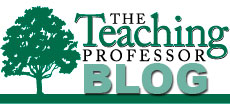There’s plenty of good research on study strategies that promote learning. It’s also well-documented that students don’t always use them. As most of us are well aware, procrastination gets in the way of learning. Cramming ends up being mostly a shoveling exercise—digging up details and dropping them into short term-memory. But there’s also evidence that students don’t know that some strategies do more for learning than others. And guess what? Neither do some faculty.
 Three researchers at the University of Colorado surveyed students and faculty on a range of questions about study strategies. “Our findings suggest that instructors’ knowledge of study skills exceeded those of the student respondents but this advantage was generally not large.” (p. 267) I’d like to use the rest of the post to explore one strategy that 67% of the 300 students regularly used and 41% of the 146 faculty regularly recommended: rereading assigned materials and class notes.
Three researchers at the University of Colorado surveyed students and faculty on a range of questions about study strategies. “Our findings suggest that instructors’ knowledge of study skills exceeded those of the student respondents but this advantage was generally not large.” (p. 267) I’d like to use the rest of the post to explore one strategy that 67% of the 300 students regularly used and 41% of the 146 faculty regularly recommended: rereading assigned materials and class notes.
The comprehensive and widely referenced review by Dunlosky, et. al. analyzed evidence for 10 different study strategies and rated rereading as having low utility. The biggest problem with rereading is it creates a false sense of security. Having seen text material more than once makes it look familiar. An important word is recognized. It may not be understood, but it looks familiar, so students convince themselves they know it. Or they remember there’s a graph in the upper left-hand corner of the page. They’ve seen it there before, they know it’s about a particular concept, but that’s a long way from understanding what’s in the graph and what it means.
Although a lot of us still struggle with getting students to do the reading—and not do it all for the first time the night before the exam—most of us also have any number of conscientious students who stay on top of their reading and then review it before the exam. That’s better, but still not what’s needed for deep learning. Put colloquially, the research recommends that students “get into” the reading or their notes rather than “going over” them. Effective study sessions provide opportunities for retrieval practice, which is why the Dunlosky team gives practice testing a high utility rating. When students ask themselves or each other questions, they have to find the answers in their minds. In other words, precisely what they will be doing on the exam. The more frequently information is retrieved, the easier it is to find.
This explains why highlighting gets a low rating. Generally, when students go over their notes and the reading, they reread what they’ve highlighted. Some of them highlight so much, there’s no indication what is most important, so the highlighting does not help prioritize the content or establish relationships between pieces of it.
I think teacher recommendations to reread course materials derive, in part, from how we read academic content. If we underline, we do so judiciously. Many of us interact with the content in the margins with stars, question marks, and written commentary. We pay attention to chapter headings and what’s in bold. Many of us pore over any graphs, tables, or diagrams. We’re good readers and it’s easy to forget that students do not approach text with the same skills we have.
So, we need to help students approach their review of notes and reading with more effective strategies and that presents another challenge, at least according findings reported previously. The University of Colorado team asked students if they had learned the approaches they used to study from a teacher. Only 36% said yes. The same question was asked in 2007 and 2012 surveys and the percentages there were 20% and 36% respectively.
Could this be another case where teaching as telling isn’t all that effective? Or, is it once again the procrastination issue? “Going over” as in rereading notes and text material can be done much more quickly than asking and answering questions about the content. I don’t think we should abandon efforts to promote better review strategies. Maybe we challenge students: look at what the research says. Why don’t you give it a try? See if using questions at the end of the chapter, in the study guide or ones you make up yourself, improves your ability to understand and remember what you need to know for the exam.
What are some effective study strategies you encourage your students to use?
References: Morehead, K., Rhodes, M. G., and DeLozier, S. (2016). Instructor and student knowledge of study strategies. Memory, 24 (2), 257-271.
Dunlosky, J., Rawson, K. A., Marsh, E. J., Nathan, M. J. and Willingham, D. T., (2013). Improving student’s learning with effective learning techniques: Promising directions from cognitive and educational psychology. Psychological Science in the Public Interest, 14 (1), 4-58.

